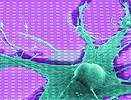
Infineon Technologies and the Max Planck Institute have jointly described how they directly connected a newly developed biosensor chip with living nerve cells to read electrical signals produced by the cells. The ‘Neuro-Chip’ development was described in a paper presented at the recent international solid-state circuits conference (ISSCC).
Neurons are the specialised cells that make up the nervous systems of all living things. Nerve tissues, comprised of many associated nerve cells, are the principal component of the brain and spinal cord. Nerve cells communicate with each other through electrical pulses, so the ability to read these signals and record them in a computer system holds the promise of new insights into neurological processes.
"Concerning the signal-to-noise ratio this chip operates close to elementary physical limits," said Dr Roland Thewes, the senior director responsible for biosensor chip activities within the corporate research centre at Infineon Technologies. "Infineon is able to draw on 50 years of knowledge in chip making to develop biochips that bring the advantages of silicon technology to biochemistry and new drug research."
According to Infineon, the neuro-chip integrates 128 x 128 sensors in an array pattern covering one square millimetre. A sophisticated electronic circuit is integrated below each sensor, which amplifies and processes the extremely weak signals for transfer to a computer system for processing. Individual neurons are placed into a nutrient solution above the sensor array, which keeps the neurons alive. Infineon says that the sensor density is approximately 300 times greater than today's common methods for studying neurons, which use glass substrates with vapour-deposited metallic lanes to contact the neuron. Each sensor on the chip is separated by a distance of just eight microns. Typical size of neurons is between 10-50 mm.

Instead of sequentially checking every single neuron, the neuro-chip surveys several neurons at the same time, which gives more statistically relevant data. Additionally, the chip enables recording of the operating sequence of electrical activity within nerve tissue over a defined time. Every second, it can record more than 2000 single values for each of its 16384 sensors. The data can then be transformed into a colour picture for visual analysis. Researchers can detect from this data how complete nerve tissues react to electrical stimulation or certain chemical substances in a given period of time.

Infineon says that the chip is based on a standard CMOS technology extended with additional process steps to realise the capacitive sensors array. Total area measures 5 x 6 mm, including the circuitry required to amplify, process, and transmit the data off-chip. The neuro-chips can detect and handle voltage changes with peaks ranging from 100 µV to 5 mV.
For more information see www.infineon.com

© Technews Publishing (Pty) Ltd | All Rights Reserved